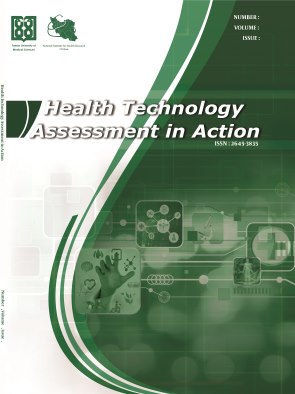Simulating Flexibility of the Smart Supply Chain in Iran’s Health Industry Using System Dynamics Approach
Abstract
Background: Making smart and digital supply chain have always been considered as a key phenomenon and a vital factor in organizational transformation. Achieving this, plays a key role in a country's health industry; The output can help the policy makers to check the level of flexibility of the smart supply chain and then provide a basis for improving the flexibility in the health industry by presenting possible scenarios.
Methods: In this study, the system dynamics approach and VENSIM DSS was used to extract and present a dynamic model to investigate and indicate smart supply chain flexibility in Iran’s health industry. The gap between the current and desired situation has been identified, and then by implementing possible scenarios that have been taken from the opinion of experts, steps have been taken to improve the flexibility of the supply chain.
Results: Base on the results, smart supply chain flexibility in Iran is not at a favorable level and probably face many problems in providing medicine and health services. Under possible scenarios, the highest level of smart supply chain flexibility in Iran's health industry relies on the institutionalization of smart warehouse or smart communication by 5% during the period under review. This will increase the average level of smart supply chain flexibility to 2.08% and 1.4%, respectively.
Conclusion: According to the scenarios, policy makers can provide the ground for improving the flexibility of the supply chain of the health industry by changing one of the two variables of smart warehouse and smart communication.
2. Kochan, C. G., Nowicki, D. R., Sauser, B., & Randall, W. S. Impact of cloud-based information sharing on hospital supply chain performance: A system dynamics framework. International Journal of Production Economics, 2018; 195: 168-185.
3. Fang, X. Optimization for a three-stage production system in the Internet of Things: Procurement, production and product recovery, and acquisition. Int. J. Adv. Manuf. Technol., 2014; 83 (3) 689–710.
4. Chen, Z., Ming, X., Zhou, T., & Chang, Y. Sustainable supplier selection for smart supply chain considering internal and external uncertainty: An integrated rough-fuzzy approach. Applied Soft Computing, 2020; 87, 106004.
5. Vahidinia, A. (2018). Evaluation of system intelligence using multi-criteria decision making method, Shahrood University of Technology, Central Library of Shahrood University of Technology, Shahrood.
6. Yinmin and F. Ruixue., (2009) An architecture of SCM system based agent and ontology. in Grey Systems and Intelligent Services, GSIS 2009. IEEE International Conference on, Nanjing, China.
7. Sargazi Moghaddam Hossein., Shahsavari Maryam,. An overview of the role of intelligent software agents in supply chain management. Supply chain management, . Iranian Journal Of Supply Chain Management, 2016; 18(53): 14-26.
8. Paik, I., Takami, S. and Watanabe, Y. (2004). Intelligent agent to support design in supply chain based on semantic web services. in Hybrid Intelligent Systems, HIS'04. Fourth International Conference on, Kitakyushu, Japan.
9. Wright, D. and Yuan, X. Mitigating the bullwhip effect by ordering policies and forecasting methods. International Journal of Production Economics, 2008; 113: 587- 597.
10. Gumus, T. and Guneri, A.F. A multi-echelon inventory management framework for stochastic and fuzzy supply chains. Expert Systems with Applications, 2009; 36: 5565-5575.
11. Lu, P. Humphreys, R. McIvor, and Maguire, L. (2007). Employing genetic algorithms to minimize the bullwhip effect in a supply chain. in Industrial Engineering and Engineering Management, IEEE International Conference on, Singapore.
12. Zhao, G. and Sun, R. (2010). Application of multi-agent Reinforcement Learning to supply chain ordering management. in Natural Computation (ICNC), Sixth International Conference on, Yantai, Shandong, China.
13. Toorajipour, R., Sohrabpour, V., Nazarpour, A., Oghazi, P. & Fischl, M. Artificial intelligence in supply chain management: A systematic literature review. Journal of Business Research, 2021; 122: 502-517.
14. Oh J, Jeong B. Tactical supply planning in smart manufacturing supply chain. Robotics and Computer-Integrated Manufacturing. 2019 Feb; 55:217-233.
15. Israel, E. F., Albert, A. E., Frazzon, M., & Hellingrath, B. Operational supply chain planning method for integrating spare parts supply chains and intelligent maintenance systems. ScienceDirect, 2017; 1(50): 12428-12433.
16. NiliporTabatabaei, A., Khayyambashi, B., Karbasian, M., Shariati, M. Optimizing the Usage of Information Technology in Supply Chain Management and Marketing of Aviation Products by AHP Approach. New Marketing Research Journal, 2012; 2(2): 143-164.
17. Rahchamani, S. M., Heydariyeh, S. A., Zargar, S. M. Designing a Model for Intelligent Service Supply Chain Based on Grounded Theory (Case Study: Omid Entrepreneurship Fund). Journal of Industrial Management Perspective, 2022; 12(Issue 2, Summer 2022): 89-111.
18. Shiva Rashidi Torbati, Reza Radfar , Nazanin Pilevari, Supply Chain Intelligence with IoT Approach(Case study: Companies active in the field of information and communication technology in Tehran province), Journal of Strategic Management in Industrial Systems, 2022; 16(58): 14-29. magiran.com/p2394748
19. Mohammadian, R., Rezaian, J., Shirazi, B. (2020). Ranking Agile and Green Supply Chain Factors in Electronic Business: Considering the Application of IoT Technology. The 2nd International Conference on Challenges and New Solutions in Industrial Engineering and Management and Accounting, Damghan, Iran.
20. Fakhrzad, M. B., Keshavarz, M., Jafari Nodoushan, A. A mathematical model in the smart supply chain based on ICPT in the MTS environment. Modern Research in Decision Making, 2021; 6(2): 97-123.
| Files | ||
| Issue | Vol 7, No 2 (2023) | |
| Section | Articles | |
| DOI | https://doi.org/10.18502/htaa.v7i2.13816 | |
| Keywords | ||
| Simulation Smart Supply Chain Flexibility Health Industry System Dynamics | ||
| Rights and permissions | |

|
This work is licensed under a Creative Commons Attribution-NonCommercial 4.0 International License. |




